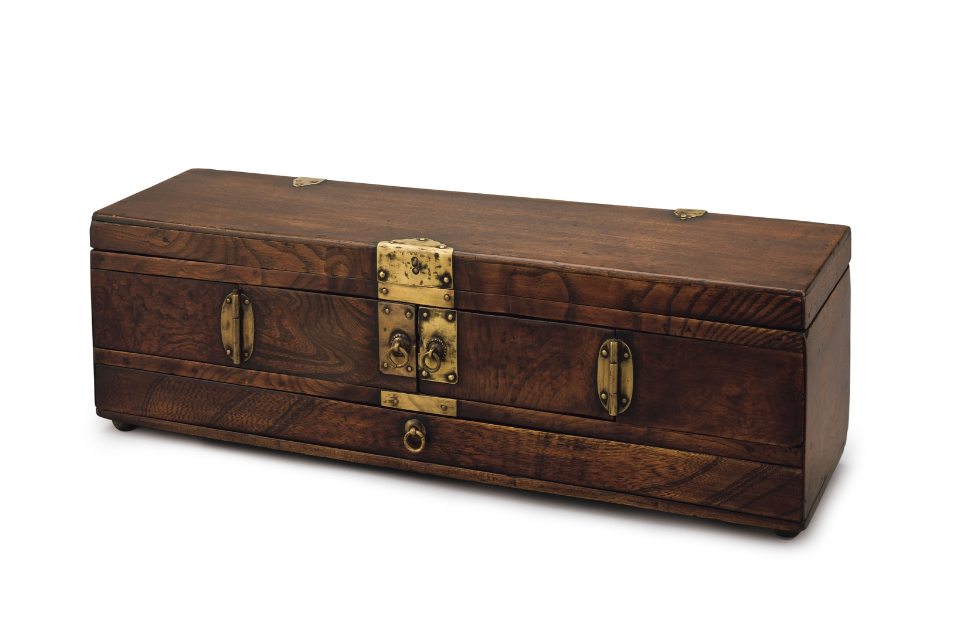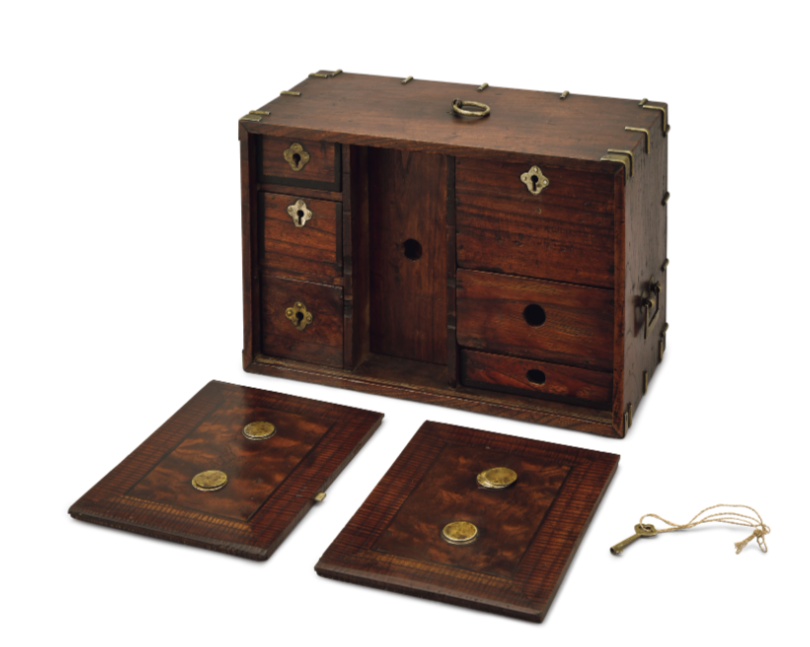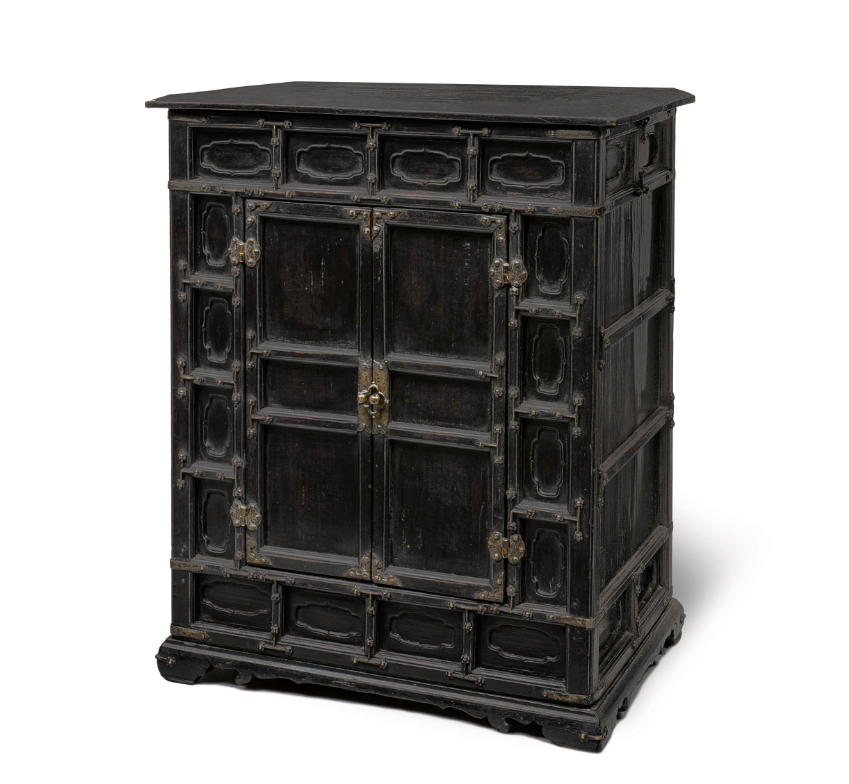AUCTIONS IN THE WEST.
This study is based on the examination of approximately 300 Korean pieces presented at various auctions around the world. We deliberately excluded furniture considered contemporary as well as those we classified as reproductions or items made for the decorative market.
The first part focuses on sales by various establishments, primarily based in the United States and Europe, and does not include renowned auction houses such as Sotheby’s and Christie’s, as well as Korean auction houses, which often feature higher-end pieces. The primary sources of information are auction platforms such as LiveAuctioneers, Invaluable and BidSquare
Of the total pieces analyzed, 69% are late-period furniture (20th century), while 31% could be considered higher-value pieces (19th century). Additionally, 32% of the lots were unsold.
Breakdown of analyzed pieces:
- Bandaji (26.3%) represent the largest category.
- Clothing storage furniture, such as Jang and Morijang, account for 24.6%.
- Boxes, including cosmetic boxes, wedding boxes, document boxes, and silver cigarette boxes, make up 15.6%.
- Tables, soban, and lacquered low tables comprise 7.5%.
- Nong chests make up 6.5%.
- Small accessories also account for 6.5%.
- Coin chests represent 4.7%.
- Rice chests constitute 2%.
- Various other items, including medicine chests, early 20th-century pieces, doors, windows, palanquins, and lamps, account for 6.3%.
Regarding the estimates and sales results, they confirm a noticeable decline in demand over several years and, at times, a lack of knowledge about the pieces, which are often significantly undervalued by experts, as evidenced by erroneous descriptions.
Large clothing and storage furniture pieces tend to have low valuations and results:
- Bandaji: $100–$300. Very few pieces between $500-$1,000.-
- Morijang: $140–$300
- Jang: $300- $400.-
- Nong: $500 and over.
Smaller items, such as various document or cosmetic storage boxes or small cabinets, achieve average values ranging between $550 and $1,000. Lacquered low tables are valued at $700–$1,500, while soban tables are estimated at $700.
BANDAJI.

January 24, 2024.
Estimate: Euros 600 – 800.-
Starting bid: Euros 600.-
SOLD for Euros 1,064.-
NOTE: This chest was previously presented in an auction by the same auctioneer in June 12, 2023.

Joseon Dynasty (1392-1897).
Height 31 3/4 x width 35 1/4 x depth 17 inches. Freeman’s Hindman, Chicago, IL, United States. July 18, 2024.
Estimate: $ 400 – 600.- Starting bid: $ 200.-
SOLD for $ 450.-
MORIJANG

Savannah, GA, US. June 26, 2024.
Estimate: $ 500 – 700.- Starting bid: $ 300.- SOLD for $ 300.-
JANG & NONG.

Carved wood. Two cabinets, eight drawers. Metal fittings. Width 100 cm, depth 45 cm, height 128 cm. Bukowskis – Arts & Business, Sweden. February 17, 2024.
Estimate: 3,000 SEK. SOLD for 3,800 SEK. US$ 364.-

57 1/2 x 40 1/4 x 19 in.
Leland Little, 620 Cornerstone Court, Hillsborough, US. February 22, 2024.
Starting bid: $ 50.- SOLD for $ 375.-

First half 20th century, three part form, appears to be elm and mixed woods, the upper case with three drawers over two hinged cabinet doors, the lower case with two hinged cabinet doors, set on a stylized scroll foot base, the whole with banded inlays and white metal mounts.
52 x 36.25 x 14 in. Leland Little. Hillsborough, NC, United States.
March 29, 2024. Estimate: $ 50 – 25,000.- Starting bid: $ 50.- SOLD for $ 375.-

SOLD for 350 GBP

Estimate: GBP 600 – 800.- Starting bid: GBP 500.-
SOLD for £9,975

Estimate: $ 400 – 600.- Starting bid: $ 350.- SOLD for $ 600.-

Starting bid: $ 1,000.- SOLD for $ 1,100.-

March 20, 2024. Estimate: $ 1,500 – 2,000.- Starting bid: $ 750.-
SOLD for $ 3,840.-

Korea, Joseon Dynasty, 19th century. Each side decorated with a medallion reserved with either a monkey, a deer, birds and chrysanthemum flowers, the cover similarly decorated with a pair of cranes, against a diaper ground, framed by a key-fret border.
5.8cm (2 1/4in) high x 9.8cm (3 7/8in) wide. Bonhams, Collector’s Treasures Asian Art Online, London, Knightsbridge. May 20, 2024.
Estimate: £1,000 – £1,500 Starting bid: £1,000. SOLD for £1,152.
A comprehensive list of these auctions can be found at: Korean furniture auctions.
KOREAN PIECES PRESENTED TO RENOWNED AUCTION HOUSES.
Sales of Korean art at Christie’s and Sotheby’s are integrated into Japanese Art or Asian Art in general. Unlike in the past (until the late 20th century), specialized Korean art sales no longer exist. This appears to be due to the difficulty of finding enough pieces. High-end items, acquired by the first foreign visitors to Korea in the late 19th to early 20th century, seem to have already been entirely redistributed. Indeed, These auctioneers mainly seek antique pieces (pre-19th century), which are nowadays very rare on the market.
For the year 2024, we recorded 7 pieces, mainly consisting of lacquered furniture or objects. Two of them did not find buyers.
These items were sold for amounts ranging from US$4,000 to US$20,000, with a record sale of a lacquered bell stand purchased for US$50,400.

JOSEON DYNASTY (17TH CENTURY).
The rectangular table set on four short inward-curving legs, decorated on top and sides in inlaid mother-of-pearl and brass wires with floral scrolls of chrysanthemum and floral latticework on black lacquer ground, applied with black lacquer on the interior
10 7/8 x 23 3/8 x 7 ¾ in. (27.6 x 59.4 x 19.7 cm.). Christie’s, Live Auction 23151 Japanese and Korean Art. September 17, 2024
Estimate: USD 25,000 – USD 35,000 UNSOLD.

Price realised: USD 50,400.-
Estimate: USD 40,000 – USD 80,000.-
Christie’s: March 19, 2024. LIVE AUCTION 22643 JAPANESE AND KOREAN ART. New York, USA.

A MOTHER-OF-PEARL INLAID RED LACQUER STORAGE CHEST. KOREA, JOSEON DYNASTY (19TH-20TH CENTURY).
327⁄8 x 23 x 163⁄4 in. (83.5 x 58.4 x 42.5 cm.)
Price realised: USD 5,670.- Estimate: USD 2,000 – USD 3,000
Christie’s March 28, 2024. ONLINE AUCTION 22712 ARTS OF ASIA ONLINE. New York, USA.

A mother-of-pearl inlaid lacquer chest, Korea, Joseon dynasty, 16th century | 朝鮮王朝十六世紀 黑漆嵌螺鈿太白箱.
Length 45.7 cm, 18 in.
Estimate: 6,000 – 8,000 EUR
Starting Bid: 4,500 EUR.
Sotheby’s Paris December 12, 2024. UNSOLD.
A comprehensive list of these auctions can be found at: Korean pieces presented to renowned auction houses.
AUCTIONS IN KOREA.
The Korean art auction market in 2024 has experienced a notable downturn, continuing the decline observed in 2023. In the first half of 2024, the total transaction amount of the eight major domestic auction houses, including Seoul Auction and K Auction, reached approximately 91.7 billion KRW (US$ 62,994,140.30), marking a 13% increase from 2023’s 81.1 billion KRW (US$ 55,712,374.90). However, this figure represents a significant drop compared to the 144.6 billion KRW (US$ 99,334,271.40) recorded during the art market boom of 2022.
The most affected sector is that of traditional art, which includes Korean furniture. In 2024, the major auction houses have focused on contemporary art sales, for which demand is much higher—a sign of the evolving market demand.
The pieces presented are of higher quality than those available in the West, and collectors tend to seek smaller items such as scholar’s furniture, lacquered furniture, and small objects.
K Auction, Seoul, Korea
We have listed around 50 items presented at auctions by K Auction. Unsold items represent 46%. Most of the sold pieces were purchased at the low estimate.
Clothing storage furniture such as Bandaji, Jang, and Nong accounts for 30%, with few finding buyers, often for values below US$ 2,500.

Estimate: 2,000,000 – 5,000,000 US$ 1,500 – 3,700.-
SOLD for KRW 2,600,000 US$ 1,777.-


H. 146cm, W. 97,5cm, D. 45cm.
Weekly online auction, September 16, 2024.
Estimate: KRW. 1,500,000 – 3,000,000 Starting bid: KRW 1,000,000
SOLD for KRW 1,100,000 US$ 752.-
Most of the pieces that garnered interest were scholar’s furniture and objects, including small desks, Mungap or stationary chests, inkstone boxes, pencil boxes, and document boxes, with average values ranging from US$ 3,000 to 5,000.

H. 33,4cm, W. 85,5cm, D. 29cm. 2 pieces. January 24, 2024.
Estimate: KRW 5,000,000 – 10,000,000.- US$ 3,800 – 7,600.-
SOLD for KRW 5,600,000.- US$ 4,000.-

H. 37,5cm, W. 75,7cm, D. 30,7cm. April Auction 2024.
Estimate: KRW 6,000,000 – 12,000,000.- US$ 4,400 – 8,900.-
SOLD for KRW 6,000,000.- US$ 4,400.-
Medicine chests, which were less frequently presented, were mostly sold for around US$ 4,500 to 5,000 per piece.

H. 112,5cm, W. 88,5cm, D. 21cm. January 24, 2024.
Estimate: KRW 6,000,000 12,000,000.- US$ 4,600 – 9,100.-
SOLD for KRW 6,000,000.- US$ 4,600.-
Other items presented included tables, soban, coin chests, shelves and mother-of-pearl furniture.

Estimate: KRW 500,000 – 1,000,000.-
Starting bid: KRW 300,000.- SOLD for KRW 1,300,000.- US$ 900.-

H. 54cm, W. 45,5cm, D. 29,5cm.
November Auction. November 20, 2024.
Estimate: 15,000,000 – 30,000,000.- US$ 11,000 – 22,000.-
SOLD for KRW. 15,000,000.- – US$ 10,704.-
Seoul Auction. Seoul, Korea.
A total of 99 pieces of furniture were auctioned by Seoul Auction in 2024. Of these, 60% remained unsold.
We recorded 24 clothing chests, including bandaji (estimated at $1,400–$8,000), jang (estimated at $700–$5,500), and nong (estimated at $700–$2,100), most of which remained unsold.

Mixed media on wood
93.5×57.7×71(h)cm, 36.8×22.7×28.0(h)in.
Online Auction. July 17, 2024.
Estimate: KRW 8,000,000 – 15,000,000
Starting bid: KRW 8,000,000.- UNSOLD.

H. 72,5cm, W. 93,5cm, D. 49cm. August Auction. August 21, 2024.
Estimate: KRW 7,000,000 – 12,000,000 Starting bid: KRW 7,000,000.- UNSOLD
The main demand is for scholar’s furniture and items, including mungap or stationery chests, desks, book chests and shelves, and document boxes, with estimate around Mungap ($400 – $500), desk ($450 – $2,000), document boxes ($1,000 – $3,000) and bookchests or shelves (respectively $3,000-$6,000 and $500).

47.8×13×15.3(h)cm, 18.8×5.1×6.0(h)in. Joseon period.
February 26, 2024.
Estimate: KRW 4,000,000 ~ 7,000,000.-
US$ 3,100 ~ 5,300.- SOLD for KRW 5,200,000 US$ 3,600.-

39.4×17.5×25.2(h)cm, 15.5×6.9×9.9(h)in. Joseon period.
February 26, 2024.
Estimate: KRW 6,000,000 ~ 10,000,000.-
US$ 4,600 ~ 7,600.-
SOLD for KRW 6,000,000 US$ 4,600.-


H. 88cm, W. 89,2cm, D. 41,6cm.
Online Auction April 17, 2024.
Estimate: KRW 3,500,000 – 6,000,000.-
Starting bid: KRW 3,500,000.- SOLD for KRW 3,700,000.- US$ 2,530.-
Note the record sale of a series of 13 wooden geese sold for $24,700.

1. 31.7×11×18.7(h)cm
2. 33.7×9.4×21.5(h)cm. 180th Art Auction. October 22, 2024.
Estimate: KRW 20,000,000 ~ 50,000,000
USD 15,000 ~ 37,500 SOLD for KRW. 36,000,000.- $24,700.
A comprehensive list of these auctions can be found at: Auctions in Korea.
In conclusion, the state of Korean antique furniture auctions in 2024 reflects a challenging yet evolving market. Western auctions continue to face a decline in demand, with many items significantly undervalued and a large portion of pieces remaining unsold. The absence of specialized Korean art sales at major auction houses like Sotheby’s and Christie’s highlights the difficulty in sourcing high-quality, pre-19th-century items. Meanwhile, in Korea, although there is a slight increase in overall transaction volume, the focus has shifted towards contemporary art, further decreasing interest in traditional pieces such as furniture. The items that perform better are smaller, high-quality pieces, like scholar’s furniture and lacquered objects, which continue to attract buyers, albeit at relatively low prices compared to their cultural value. The downturn in the market calls for greater recognition and expertise to preserve the legacy and value of Korean antiques, particularly in international auctions.

